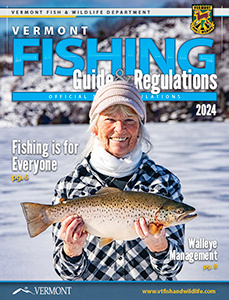Toxic Lead
How Do Mercury and Lead Get Into Wildlife?
Mercury
Mercury is a toxic heavy metal that can become particularly concentrated in large, carnivorous fish. It has been found at levels exceeding health guidelines for some people in some freshwater fish. While the benefits of eating fish generally outweigh the risks of mercury exposure, women who are pregnant and young children should select fish with low levels of mercury. Brook trout, brown trout, rainbow trout, and yellow perch have lower mercury levels, while walleye, smallmouth bass, and chain pickerel show the highest concentrations of mercury.
Please see www.healthvermont.gov or www.mercvt.org for the most current advisory.
Lead
Loons and some other water birds can die from lead poisoning after swallowing lead fishing sinkers and jigs lost by anglers; up to 50 percent of adult loon deaths are the result of lead poisoning. You can help by switching to nonlead fishing tackle and by helping to spread the word to others to do the same. Lead is the leading cause of observed loon deaths here in the Northeast. It is illegal to use lead sinkers weighing one-half ounce or less.
What can you do to help?
- Use nonlead fishing tackle.
- Spread the word. Tell other anglers about the problem and encourage them to switch to nonlead alternatives.
- Remove lead sinkers and jigs from your tackle box.
- Remove spent fishing line and other materials from Vermont waters and shorelines to reduce entanglement, another major cause of loon deaths.
- Maintain a respectful distance from loons and other wild animals. Use binoculars to get a great view.
- Support continuing loon and other nongame wildlife conservation efforts by: donating to the Vermont Nongame Wildlife Fund on your Vermont income tax form; by purchasing Vermont Conservation license plates for your vehicle; or by purchasing a Vermont Habitat Stamp.
Preventing Human Lead Exposure From Fishing Sinkers
Some fishing sinkers contain lead, which is toxic when eaten, breathed in, or absorbed through the skin. In order to prevent exposure to lead, please handle lead sinkers with care and use the following guidelines:
- Switch to sinkers that do not contain lead. Alternatives to lead sinkers are made of steel, bismuth, tungsten, resin, and glass.
- Wash hands with soap after holding or using
lead sinkers. - Never put lead sinkers in your mouth or allow young children to handle lead sinkers or put them in their mouths.
- If you suspect lead poisoning in your child or yourself, call the Vermont Department of Health, Healthy Homes Lead Poisoning Prevention Program at (800) 439-8550 or (802) 863-7220.

